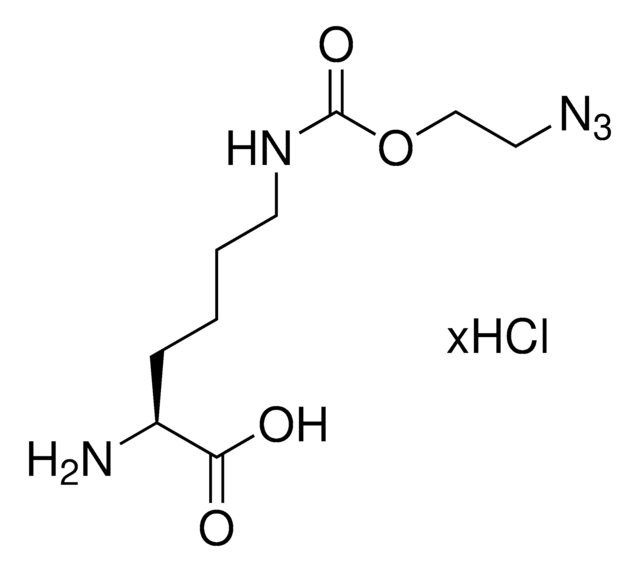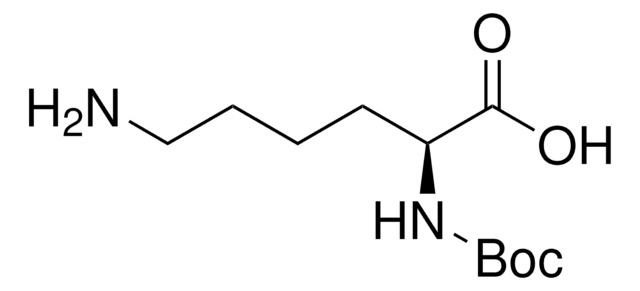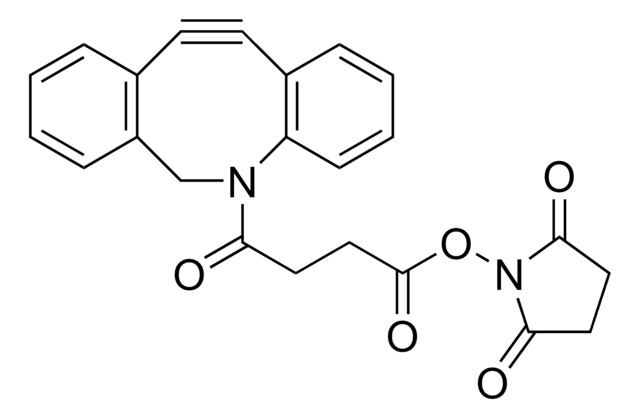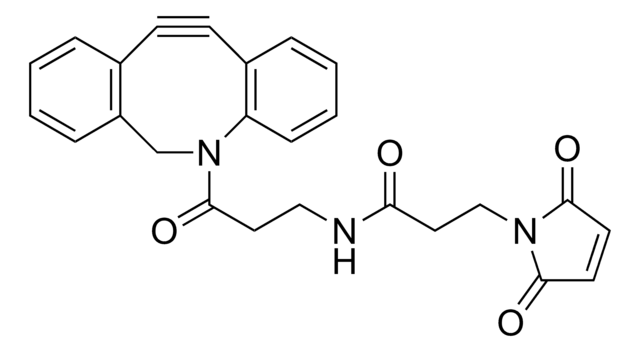914827
N6-((Prop-2-yn-1-yloxy)carbonyl)-L-lysine hydrochloride
≥98%
Synonym(s):
(S)-Amino-6-((prop-2-ynyloxy)carbonylamino)hexanoic acid hydrochloride, Clickable amino acid for bioconjugation, H-L-Lys(Poc)-OH HCl, Lysine-alkyne, Plk, Propargyl-derivatized lysize, UAA crosslinker
Sign Into View Organizational & Contract Pricing
All Photos(2)
About This Item
Empirical Formula (Hill Notation):
C10H16N2O4 · xHCl
CAS Number:
Molecular Weight:
228.25 (free base basis)
UNSPSC Code:
12352200
Recommended Products
Assay
≥98%
form
powder
storage temp.
2-8°C
Application
N6-((Prop-2-yn-1-yloxy)carbonyl)-L-lysine hydrochloride is a clickable amino acid derivative for site-specific incorporation into recombinant proteins or synthesis of chemical probes and tools for biological applications. This non-canonical lysine possesses an alkyne for bioorthogonal reaction with azides.
Other Notes
Site-Specific Encoding of Photoactivity in Antibodies Enables Light-Mediated Antibody-Antigen Binding on Live Cells Quick View Other Sources
PEGylated polylysine derived copolymers with reduction-responsive side chains for anticancer drug delivery
Construction of bacterial cells with an active transport system for unnatural amino acids
Semisynthesis of an Active Enzyme by Quantitative Click Ligation
Combined Use of Unnatural Amino Acids Enables Dual-Color Super-Resolution Imaging of Proteins via Click Chemistry
PEGylated polylysine derived copolymers with reduction-responsive side chains for anticancer drug delivery
Construction of bacterial cells with an active transport system for unnatural amino acids
Semisynthesis of an Active Enzyme by Quantitative Click Ligation
Combined Use of Unnatural Amino Acids Enables Dual-Color Super-Resolution Imaging of Proteins via Click Chemistry
related product
Product No.
Description
Pricing
Storage Class Code
11 - Combustible Solids
WGK
WGK 3
Flash Point(F)
Not applicable
Flash Point(C)
Not applicable
Choose from one of the most recent versions:
Certificates of Analysis (COA)
Lot/Batch Number
Sorry, we don't have COAs for this product available online at this time.
If you need assistance, please contact Customer Support.
Already Own This Product?
Find documentation for the products that you have recently purchased in the Document Library.
Robert Serfling et al.
Nucleic acids research, 46(1), 1-10 (2017-11-28)
The pyrrolysyl-tRNA synthetase/tRNAPyl pair is the most versatile and widespread system for the incorporation of non-canonical amino acids (ncAAs) into proteins in mammalian cells. However, low yields of ncAA incorporation severely limit its applicability to relevant biological targets. Here, we
Silvia Eger et al.
Methods in molecular biology (Clifton, N.J.), 832, 589-596 (2012-02-22)
The conjugation of poly-ubiquitin chains is a widespread post-translational modification of proteins that plays a role in many different cellular processes. Notably, the biological function of the attached ubiquitin chain depends on which lysine residue is used for chain formation.
Andreas Schmidt et al.
ACS chemical biology, 13(9), 2472-2483 (2018-08-01)
Single-molecule techniques allow unique insights into biological systems as they provide unrivaled access to structural dynamics and conformational heterogeneity. One major bottleneck for reliable single-molecule Förster resonance energy transfer (smFRET) analysis is the identification of suitable fluorophore labeling sites that
Ivana Nikić et al.
Angewandte Chemie (International ed. in English), 53(8), 2245-2249 (2014-01-30)
The growing demands of advanced fluorescence and super-resolution microscopy benefit from the development of small and highly photostable fluorescent probes. Techniques developed to expand the genetic code permit the residue-specific encoding of unnatural amino acids (UAAs) armed with novel clickable
Jihe Liu et al.
Journal of the American Chemical Society, 139(27), 9100-9103 (2017-06-29)
Site-specific incorporation of unnatural amino acids into proteins provides a powerful tool to study protein function. Here we report genetic code expansion in zebrafish embryos and its application to the optogenetic control of cell signaling. We genetically encoded four unnatural
Our team of scientists has experience in all areas of research including Life Science, Material Science, Chemical Synthesis, Chromatography, Analytical and many others.
Contact Technical Service








